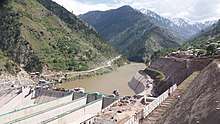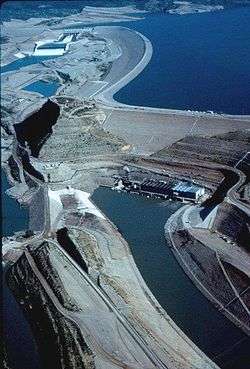Neelum–Jhelum Hydropower Plant
| Neelum–Jhelum Dam | |
|---|---|
 , LOT-C1, Neelum Jhelum Hydropower Project | |
 Location of Neelum–Jhelum Dam in Pakistan | |
| Country | Pakistan |
| Location | Muzaffarabad, Azaad (Independent) Kashmir |
| Coordinates | 34°23′34″N 73°43′08″E / 34.39278°N 73.71889°ECoordinates: 34°23′34″N 73°43′08″E / 34.39278°N 73.71889°E |
| Status | completed |
| Construction began | 2008 |
| Opening date | 14 August 2018 |
| Construction cost | Rs. 515 Billion ($5.1 billion, Levelised Tariff Rs 13.50 per unit) |
| Owner(s) | Water and Power Development Authority |
| Dam and spillways | |
| Type of dam | Concrete gravity |
| Impounds | Neelum River |
| Height | 60 m (197 ft) |
| Length | 125 m (410 ft) |
| Dam volume | 156,000 m3 (204,040 cu yd)[1] |
| Reservoir | |
| Total capacity | 8,000,000 m3 (6,486 acre⋅ft) |
| Neelum-Jhelum Hydropower Plant | |
| Coordinates | 34°11′54″N 73°30′41″E / 34.19833°N 73.51139°E |
| Commission date | March 2018 |
| Type | Conventional, diversion |
| Hydraulic head | 420 m (1,378 ft) |
| Turbines | 4 x 242.25 MW Francis-type |
| Installed capacity | 969 MW |
| Annual generation | 5,150 GWh |
The Neelum–Jhelum Hydropower Plant is part of a run-of-the-river hydroelectric power scheme in Pakistan, designed to divert water from the Neelum River to a power station on the Jhelum River. The power station is located in (Independent)Azad Kashmir, 42 km (26 mi) south of Muzaffarabad, and has an installed capacity of 969 MW. Construction on the project began in 2008 after a Chinese consortium was awarded the construction contract in July 2007. After delay of many years, the first generator was commissioned in April 2018 and the entire project is completed in August 2018 when the fourth and last unit was synchronized with the national grid on 13 August and attained its maximum generation capacity of 969 MW on August 14, 2018.[2] It will generate 5,150 gigawatt per year at the levelised tariff of Rs 13.50 per unit for 30 years.
Background
After being approved in 1989, the design was improved, increasing the tunnel length and generation capacity. The project was intended to begin in 2002 and be completed in 2008 but this time-frame experienced significant delays due to problems meeting rising costs.[3] Additionally, the 2005 Kashmir earthquake which devastated the region required a redesign of the project to conform to more stringent seismic standards.[4]
On 7 July 2007, the Chinese consortium CGGC-CMEC (Gezhouba Group and China National Machinery Import and Export Corporation) were offered a contract to construct the dam and power station. Terms were settled by the end of the year and in January 2008, the letter of commencement was issued. On 8 February, Pakistan's President Pervez Musharraf announced that the project would begin.[5] In October 2011, the diversion tunnel required to reroute the Neelum River around the dam site was completed.[6]
On 1 November, Pakistan's Prime Minister Syed Yusuf Raza Gilani publicly stated his concern for the project's delay. At its appraisal in 1989, it was to cost $167 million USD (2011) and after another redesign in 2005, that cost rose to $935 million USD (2011). Currently costs have risen to $2.89 billion USD (2011).[7] The project is being constructed under the supervision of the Water and Power Development Authority (WAPDA) and funding is being achieved through the Neelum Jhelum Hydropower Company, taxes, bond offerings, Middle Eastern and Chinese banks. WAPDA has successfully secured loans from a consortium of Chinese banks and from Middle East. Tunnel-boring machines (TBM) were brought to help speed up the excavation of the remaining tunnels. They became operational in February 2013.[8] The project was 66 percent complete as of August 2013 while at the same time the diversion tunnel was 75 percent complete. US$475 million in funding was still not secured by the Economic Affairs Division at that time.[9] In mid-2014 Prime Minister Nawaz Sharif visited the construction site and expressed the hope that at least one generator would be operational by mid-2015. On 24 December 2014 a wall near the diversion tunnel's intake collapsed, killing four workers including a Chinese engineer.[10] On November 05, 2016, the project entered into terminal phase with 100 percent perfect design while achieving 85.5 percent progress and is heading towards completion despite all delays in release of funds, weather conditions, non-availability of power during early stage of construction and delays in land acquisition. [11]
In Mar 2017 it was reported that the cost of the dam had escalated to PKR 500 Billion.[12] thus the cost of electricity from Neelum Jhelum will be Pakistani Rupees 20 per unit. [13]
All the civil work including tunnel boring, installation of generators and turbines was completed and water filling of the dam began on October 17, 2017 to put it on the test. [14]
In October 2017, residents of Muzaffarabad expressed serious concerns that the commissioning of Neelum Jhelum project will drastically reduce the flow of Neelum river thru Muzaffarabad town.[15]
In Jan 2018 it was reported that the retaining wall of the rock filled dam has got shifted by 18mm from its original position in Nov 2017 when the dam was loaded to design height of 1017 meter. The electricity generation from the dam may be delayed to June-July 2018. [16]
In early March 2018 it was reported that the filling of water in the head race tunnel has started and the first unit will start electricity generation by end-March, followed by the second, third and fourth units at one month intervals respectively [17]
In April 2018 the first unit of 242.25 MW was commissioned at a levelised tariff of Rs 13.50 per unit.
The strategically crucial Neelum-Jhelum Hydropower Project achieved a historic landmark, as the project attained its maximum generation capacity of 969 megawatts (MW) on 14 August 2018. All units of the project are generating power to their maximum capacity.[2]
Impact of India's Kishanganga Project

In 2007, India began construction on a run-of-the-river power station on the Kishanganga (Neelum) River upstream of the Neelum–Jhelum Dam. The Kishanganga Hydroelectric Plant operates in a similar sense as the Neelum–Jhelum, using a dam to divert the Kishanganga (Neelum) River to a power station before it is discharged into Wular Lake which is fed by the Jhelum River. The Kishanganga Project will divert a portion of the Neelum River from Pakistan which will reduce power generation at the Neelum–Jhelum Hydropower Plant. India states the project will divert 10 percent of the river's flow while other estimates stand as high as 33 percent. Nevertheless, water flow below the Neelum–Jhelum Dam, in Pakistan's Neelum Valley, is expected to be minimal as both projects are diverting water to the Jhelum River. This has the potential to have adverse impacts in the Neelum Valley.[18]
In 2010, Pakistan appealed to the Hague's Permanent Court of Arbitration (CoA), complaining that the Kishanganga Hydroelectric Plant violates the Indus River Treaty by increasing the catchment of the Jhelum River and depriving Pakistan of its water rights. In June 2011, the CoA visited both the Kishanganga and Neelum–Jhelum Projects. In August 2011, they ordered India to submit more technical data on the project.[19] India had previously reduced the height of the dam from 98 m (322 ft) to 37 m (121 ft).[20] After their application was first rejected, the court asked India late September to stop constructing any permanent works that would inhibit restoration of the river. While India could not construct the dam, they continued work on the tunnel and power plant.[21] In February 2013 the Hague ruled that India could divert a minimum of water for the Kishanganga Hydroelectric Plant.[22]
Design and operation
The Neelum–Jhelum Dam will be a 60 m (197 ft) tall and 125 m (410 ft) long gravity dam. It will withhold a pondage (reservoir) with a 8,000,000 m3 (6,486 acre⋅ft) capacity of which 2,800,000 m3 (2,270 acre⋅ft) is peak storage. The dam diverts up to 280 m3/s (9,888 cu ft/s) of the Neelum southeast into a 28.5 km (18 mi) long head-race tunnel, the first 15.1 km (9 mi) of the head-race is two tunnels which later meet into one. The tunnel passes 380 m (1,247 ft) below the Jhelum River and through its bend. At the terminus of the tunnel, the water reaches the surge chamber which contains a 341 m (1,119 ft) tall surge shaft (to prevent water hammer) and a 820 m (2,690 ft) long surge tunnel. From the surge chamber, the water is split into four different penstocks which feed each of the four 242 MW Francis turbine-generators in the underground power house. After being used to generate electricity, the water is discharged southeast back into the Jhelum River at 34°10′29″N 73°29′34″E / 34.17472°N 73.49278°E through a 3.5 km (2 mi) long tail-race tunnel. The drop in elevation between the dam and power station afford an average hydraulic head of 420 m (1,378 ft).[8]
Corruption allegations
It is alleged that the procurement of TBM machines resulted in $74 million in kickbacks, according to Transparency International Pakistan.[23]
See also
References
- ↑ "Neelum-Jeelum Hydropower Station". China Gezhouba (Group) Corporation. Archived from the original on 23 June 2007. Retrieved 9 January 2012.
- 1 2 "Neelum-Jhelum project attains full generation capacity of 969MW". Retrieved 16 August 2018.
- ↑ "Neelum-Jhelum Hydropower Project" (PDF). Water Info. Retrieved 19 December 2011.
- ↑ "Neelum-Jhelum Hydropower Project delayed for 7–8 months". The News (Pakistan). 22 November 2015. Retrieved 13 March 2016.
- ↑ "Commencement of Neelam- Jhelum Hydroelectric Project". China Gezhouba Group Corporation. Archived from the original on 26 May 2012. Retrieved 19 December 2011.
- ↑ "Jhelum Hydropower Project Dam Diversion Tunnel completed". OfficialNews.pk. 11 October 2011. Archived from the original on 26 April 2012. Retrieved 19 December 2011.
- ↑ "PM displeased with delay in Neelum-Jhelum project". International News. Retrieved 19 December 2011.
- 1 2 "Nhelum Jhelum Hydropower Project". Water and Power Development Authority. Archived from the original on 29 December 2011. Retrieved 19 December 2011.
- ↑ Kiani, Khaleeq (4 September 2014). "Neelum-Jhelum project facing financial problems". Dawn. Retrieved 10 January 2015.
- ↑ "Chinese engineer among four killed in Neelum-Jhelum dam accident". Dawn. 24 December 2014. Retrieved 10 January 2015.
- ↑ https://www.thenews.com.pk/print/162544-Neelum-Jhelum-project-enters-terminal-phase-CEO
- ↑ https://www.pakistantoday.com.pk/2017/03/09/cost-of-969mw-neelum-jhelum-hydropower-project-increased-to-rs-500bln/
- ↑ https://www.thenews.com.pk/print/166564-Neelum-Jhelum-projects-electricity-to-cost-Rs20-per-unit
- ↑ https://tribune.com.pk/story/1534015/water-filling-begins-neelum-jhelum-project/
- ↑ https://www.dawn.com/news/1367049
- ↑ https://www.thenews.com.pk/print/275086-will-neelum-jhelum-project-get-operational-by-march-23
- ↑ https://tribune.com.pk/story/1648558/2-hydel-power-neelum-jhelum-set-start-electricity-generation/
- ↑ "Neelum-Jhelum project contract awarding: delay led India to begin Kishanganga hydel works". FOREX.pk. Archived from the original on 11 July 2012. Retrieved 19 December 2011.
- ↑ "Kishanganga issue: Pakistan offers no comments to CoA". Business Recorded. 18 October 2011. Retrieved 19 December 2011.
- ↑ "Q.2506 Lowering of height of kishanganga dam". Indian Ministry of External Affairs. 25 August 2011. Archived from the original on 26 April 2012. Retrieved 20 December 2011.
- ↑ "Hague Court asks India to stop Kishanganga project". The International News. 25 September 2011. Retrieved 20 December 2011.
- ↑ "India can divert only minimum water from Kishanganga: tribunal". Dawn. Retrieved 20 February 2013.
- ↑ http://nation.com.pk/national/03-Jan-2013/nab-pm-secretariat-reluctant-to-take-action
